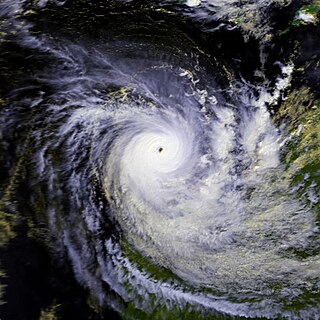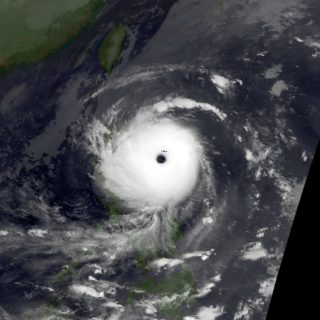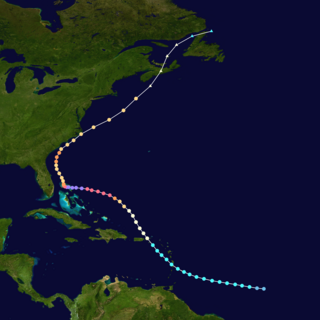Categories
| Saffir–Simpson scale | ||||||
| TD | TS | C1 | C2 | C3 | C4 | C5 |
The scale separates hurricanes into five different categories based on wind. The U.S. National Hurricane Center classifies hurricanes of Category 3 and above as major hurricanes, and the Joint Typhoon Warning Center classifies typhoons of 150 mph (240 km/h) or greater (strong Category 4 and Category 5) as super typhoons. Most weather agencies use the definition for sustained winds recommended by the World Meteorological Organization (WMO), which specifies measuring winds at a height of 33 ft (10.1 m) for 10 minutes, and then taking the average. By contrast, the U.S. National Weather Service, Central Pacific Hurricane Center and the Joint Typhoon Warning Center define sustained winds as average winds over a period of one minute, measured at the same 33 ft (10.1 m) height, [13] [14] and that is the definition used for this scale.
The five categories are described in the following subsections, in order of increasing intensity. [15] Intensity of example hurricanes is from both the time of landfall and the maximum intensity.
Category 1
| Category 1 | |
|---|---|
| Sustained winds | Most recent landfall |
| 33–42 m/s 64–82 kn 119–153 km/h 74–95 mph |  Debby in 2024 at landfall in Florida Debby in 2024 at landfall in Florida |
Very dangerous winds will produce some damage
Category 1 storms usually cause no significant structural damage to most well-constructed permanent structures; however, they can topple unanchored mobile homes, as well as uproot or snap weak trees. Poorly attached roof shingles or tiles can blow off. Coastal flooding and pier damage are often associated with Category 1 storms. Power outages are typically widespread to extensive, sometimes lasting several days. Even though it is the least intense type of hurricane, they can still produce widespread damage and can be life-threatening storms. [8]
Hurricanes that peaked at Category 1 intensity and made landfall at that intensity include: Juan (1985), Ismael (1995), Danny (1997), Stan (2005), Humberto (2007), Isaac (2012), Manuel (2013), Earl (2016), Newton (2016), Nate (2017), Barry (2019), Lorena (2019), Hanna (2020), Isaias (2020), Gamma (2020), Nicholas (2021), Pamela (2021), Julia (2022), Lisa (2022), Nicole (2022), and Debby (2024).
Category 2
| Category 2 | |
|---|---|
| Sustained winds | Most recent landfall |
| 43–49 m/s 83–95 kn 154–177 km/h 96–110 mph |  Francine in 2024 at landfall near Morgan City, Louisiana |
Extremely dangerous winds will cause extensive damage
Storms of Category 2 intensity often damage roofing material (sometimes exposing the roof) and inflict damage upon poorly constructed doors and windows. Poorly constructed signs and piers can receive considerable damage and many trees are uprooted or snapped. Mobile homes, whether anchored or not, are typically damaged and sometimes destroyed, and many manufactured homes also suffer structural damage. Small craft in unprotected anchorages may break their moorings. Extensive to near-total power outages and scattered loss of potable water are likely, possibly lasting many days. [8]
Hurricanes that peaked at Category 2 intensity and made landfall at that intensity include: Alice (1954), Ella (1958), Ginny (1963), Fifi (1974), Diana (1990), Gert (1993), Rosa (1994), Erin (1995), Alma (1996), Marty (2003), Juan (2003), Alex (2010), Richard (2010), Tomas (2010), Carlotta (2012), Arthur (2014), Sally (2020), Olaf (2021), Rick (2021), Agatha (2022), and Francine (2024).
Category 3
| Category 3 | |
|---|---|
| Sustained winds | Most recent landfall |
| 50–58 m/s 96–112 kn 178–208 km/h 111–129 mph | 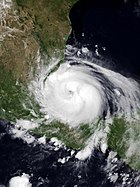 Grace in 2021 just prior to its Veracruz landfall |
Devastating damage will occur
Tropical cyclones of Category 3 and higher are described as major hurricanes in the Atlantic, Eastern Pacific, and Central Pacific basins. These storms can cause some structural damage to small residences and utility buildings, particularly those of wood frame or manufactured materials with minor curtain wall failures. Buildings that lack a solid foundation, such as mobile homes, are usually destroyed, and gable-end roofs are peeled off. Manufactured homes usually sustain severe and irreparable damage. Flooding near the coast destroys smaller structures, while larger structures are struck by floating debris. A large number of trees are uprooted or snapped, isolating many areas. Additionally, terrain may be flooded well inland. Near-total to total power loss is likely for up to several weeks and water will likely also be lost or contaminated. [8]
Hurricanes that peaked at Category 3 intensity and made landfall at that intensity include: Easy (1950), Carol (1954), Hilda (1955), Audrey (1957), Olivia (1967), Ella (1970), Caroline (1975), Eloise (1975), Olivia (1975), Alicia (1983), Elena (1985), Roxanne (1995), Fran (1996), Isidore (2002), Jeanne (2004), Lane (2006), Karl (2010),Otto (2016), Zeta (2020), and Grace (2021).
Category 4
| Category 4 | |
|---|---|
| Sustained winds | Most recent landfall |
| 58–70 m/s 113–136 kn 209–251 km/h 130–156 mph |  Lidia in 2023 just prior to its Jalisco landfall Lidia in 2023 just prior to its Jalisco landfall |
Catastrophic damage will occur
Category 4 hurricanes tend to produce more extensive curtainwall failures, with some complete structural failure on small residences. Heavy, irreparable damage and near-complete destruction of gas station canopies and other wide span overhang type structures are common. Mobile and manufactured homes are often flattened. Most trees, except for the hardiest, are uprooted or snapped, isolating many areas. These storms cause extensive beach erosion, while terrain may be flooded far inland. Total and long-lived electrical and water losses are to be expected, possibly for many weeks. [8]
The 1900 Galveston hurricane, the deadliest natural disaster to hit the United States, peaked at an intensity that corresponds to a modern-day Category 4 storm. Other examples of storms that peaked at Category 4 intensity and made landfall at that intensity include: Hazel (1954), Gracie (1959), Donna (1960), Carla (1961), Flora (1963), Betsy (1965), Celia (1970),Carmen (1974) Madeline (1976), Frederic (1979), Joan (1988), Iniki (1992), Charley (2004), Dennis (2005), Ike (2008), Harvey (2017), Laura (2020), Eta (2020), Iota (2020), Ida (2021), and Lidia (2023).
Category 5
| Category 5 | |
|---|---|
| Sustained winds | Most recent landfall |
| ≥ 70 m/s ≥ 137 kn ≥ 252 km/h ≥ 157 mph | 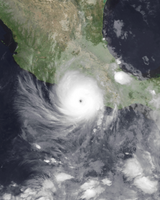 Otis in 2023 nearing its landfall in Acapulco, Mexico Otis in 2023 nearing its landfall in Acapulco, Mexico |
Catastrophic damage will occur
Category 5 is the highest category of the Saffir–Simpson scale. These storms cause complete roof failure on many residences and industrial buildings, and some complete building failures with small utility buildings blown over or away. The collapse of many wide-span roofs and walls, especially those with no interior supports, is common. Very heavy and irreparable damage to many wood-frame structures and total destruction to mobile/manufactured homes is prevalent. Only a few types of structures are capable of surviving intact, and only if located at least 3 to 5 miles (5 to 8 km) inland. They include office, condominium and apartment buildings and hotels that are of solid concrete or steel frame construction, multi-story concrete parking garages, and residences that are made of either reinforced brick or concrete/cement block and have hipped roofs with slopes of no less than 35 degrees from horizontal and no overhangs of any kind, and if the windows are either made of hurricane-resistant safety glass or covered with shutters. Unless most of these requirements are met, the catastrophic destruction of a structure may occur. [8]
The storm's flooding causes major damage to the lower floors of all structures near the shoreline, and many coastal structures can be completely flattened or washed away by the storm surge. Virtually all trees are uprooted or snapped and some may be debarked, isolating most affected communities. Massive evacuation of residential areas may be required if the hurricane threatens populated areas. Total and extremely long-lived power outages and water losses are to be expected, possibly for up to several months. [8]
Historical examples of storms that made landfall at Category 5 status include: "Cuba" (1924), "Okeechobee" (1928), "Bahamas" (1932), "Cuba–Brownsville" (1933), "Labor Day" (1935), Janet (1955), Inez (1966), Camille (1969), Edith (1971), Anita (1977), David (1979), Gilbert (1988), Andrew (1992), Dean (2007), Felix (2007), Irma (2017), [16] Maria (2017), [17] Michael (2018), [18] Dorian (2019), and Otis (2023) (the only Pacific hurricane to make landfall at Category 5 intensity).





